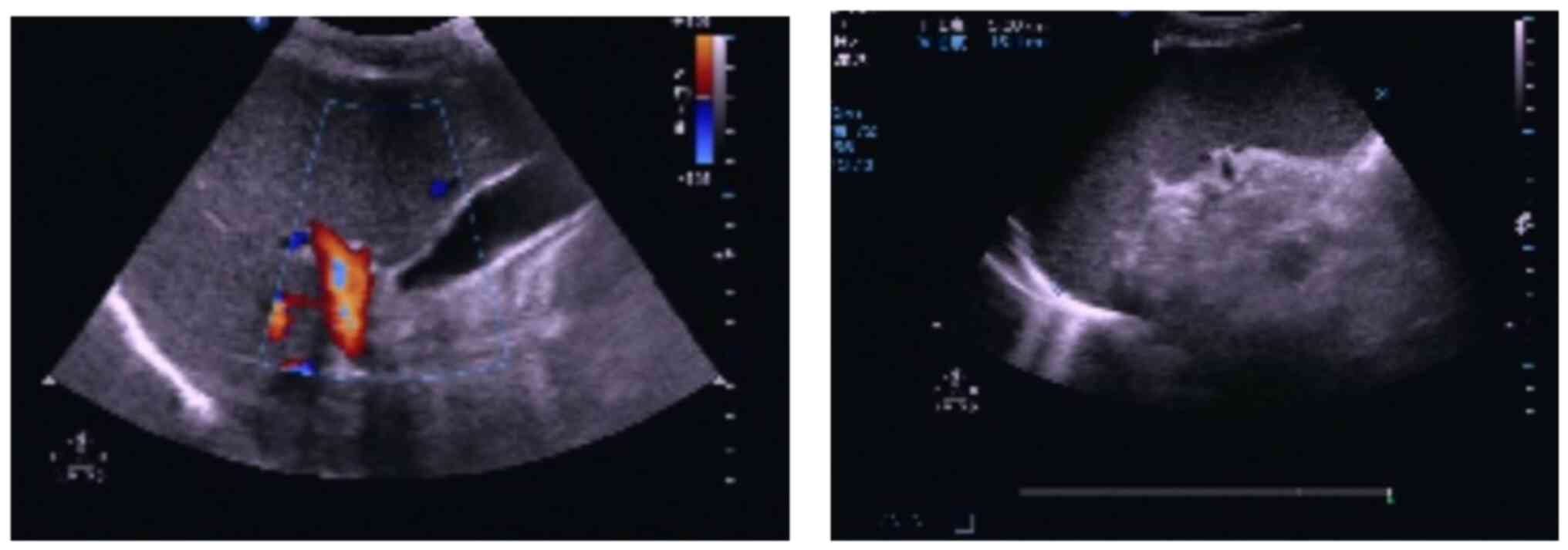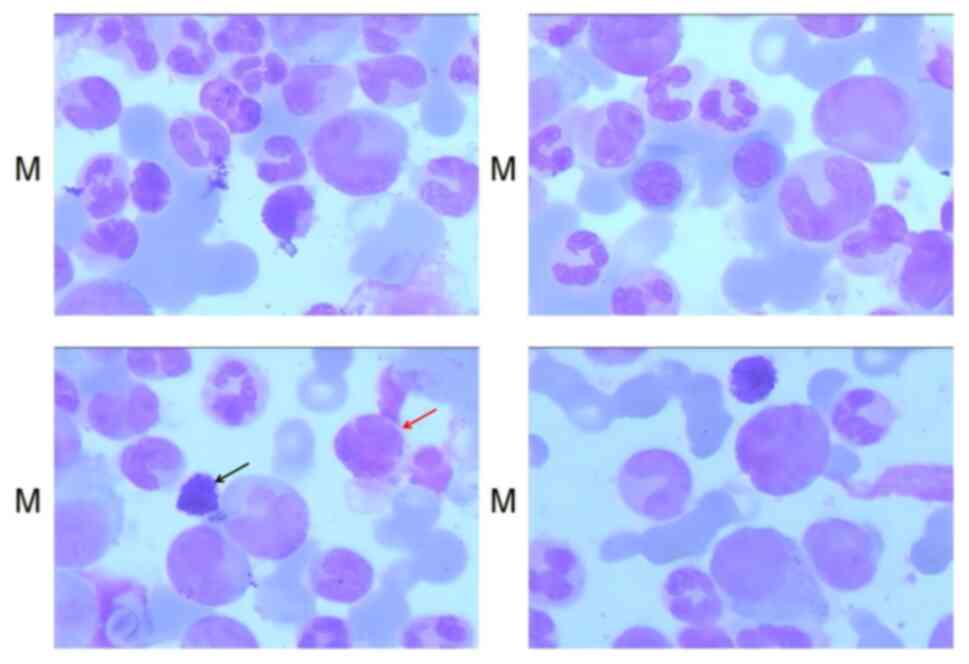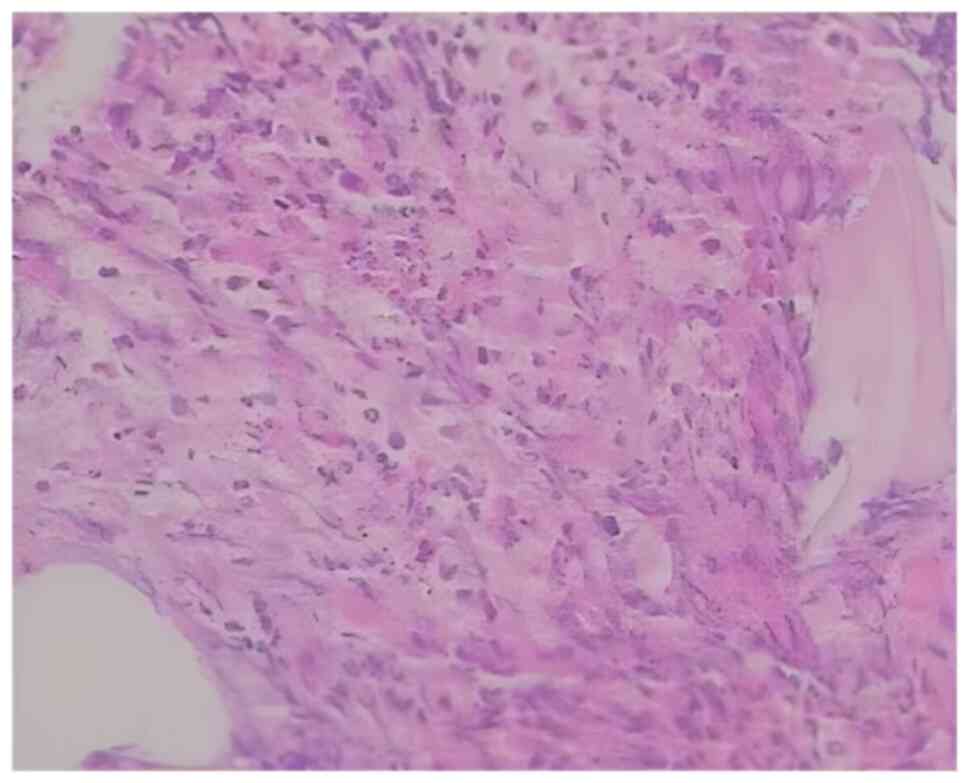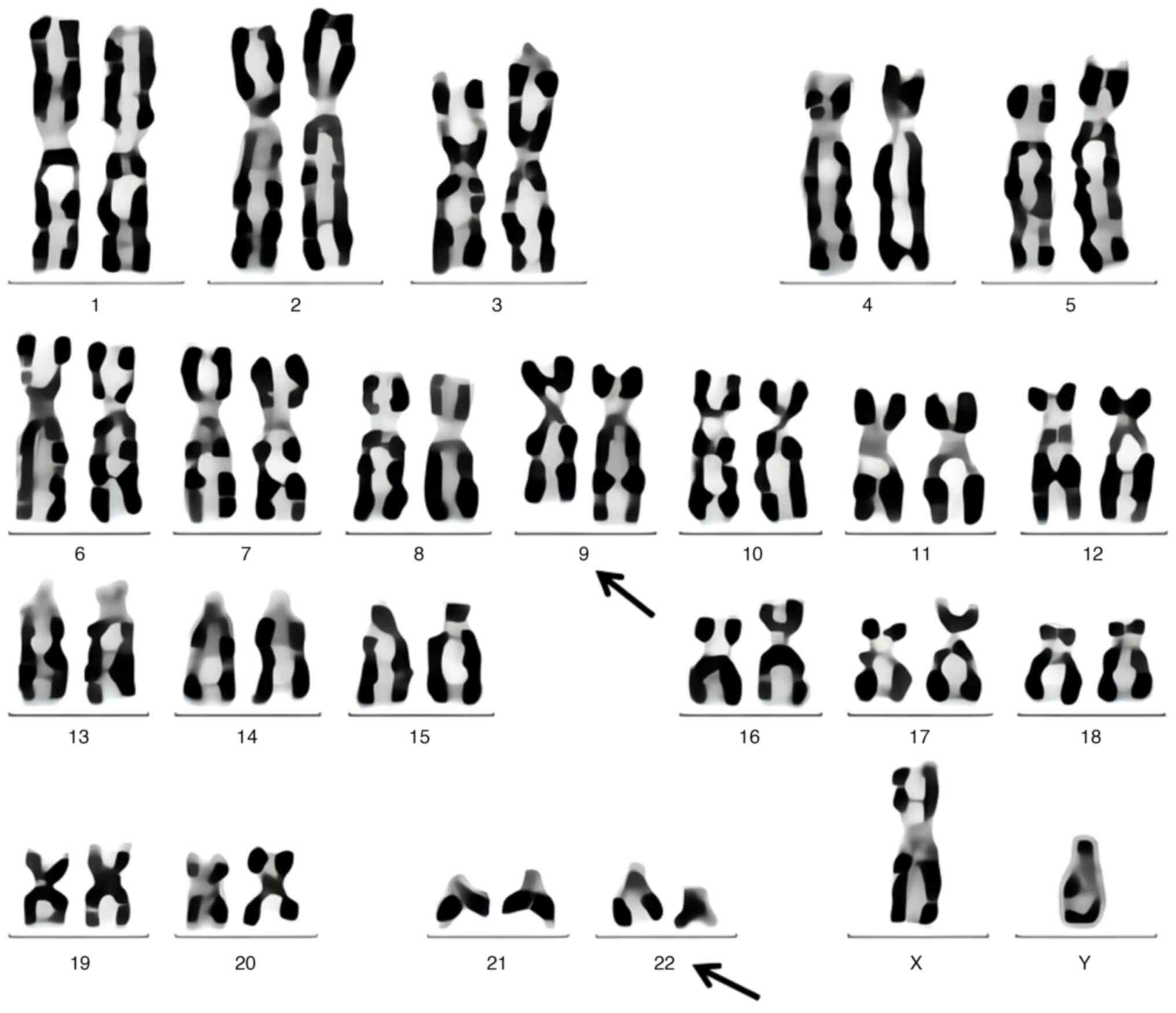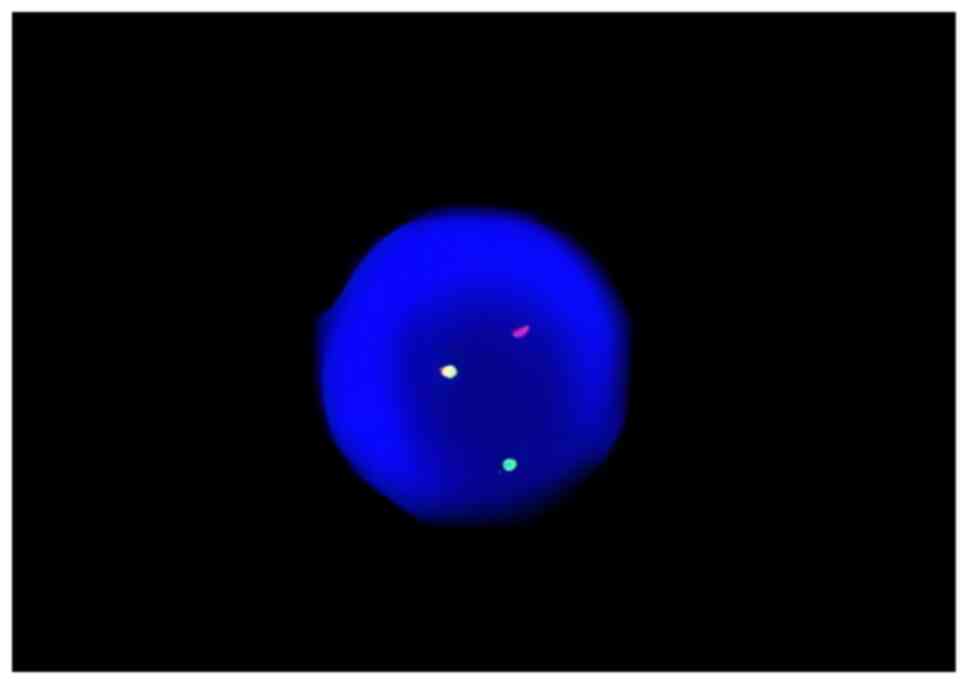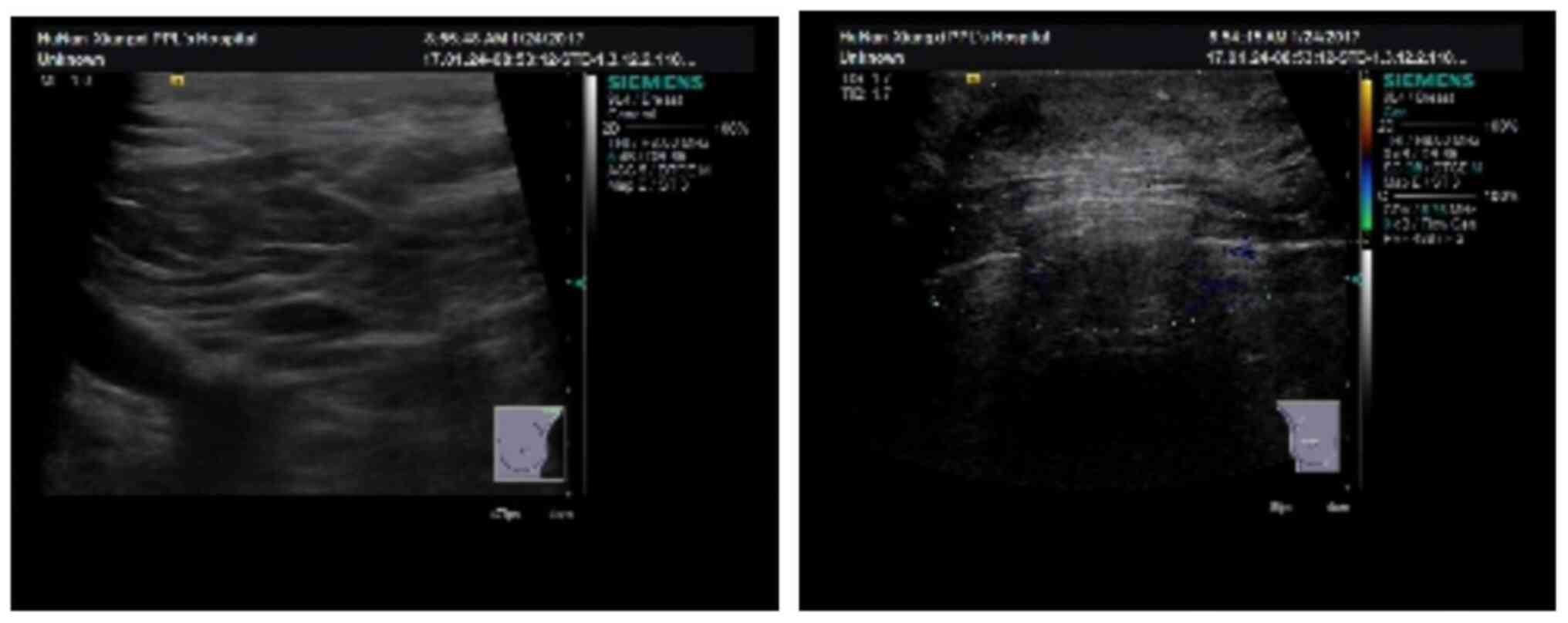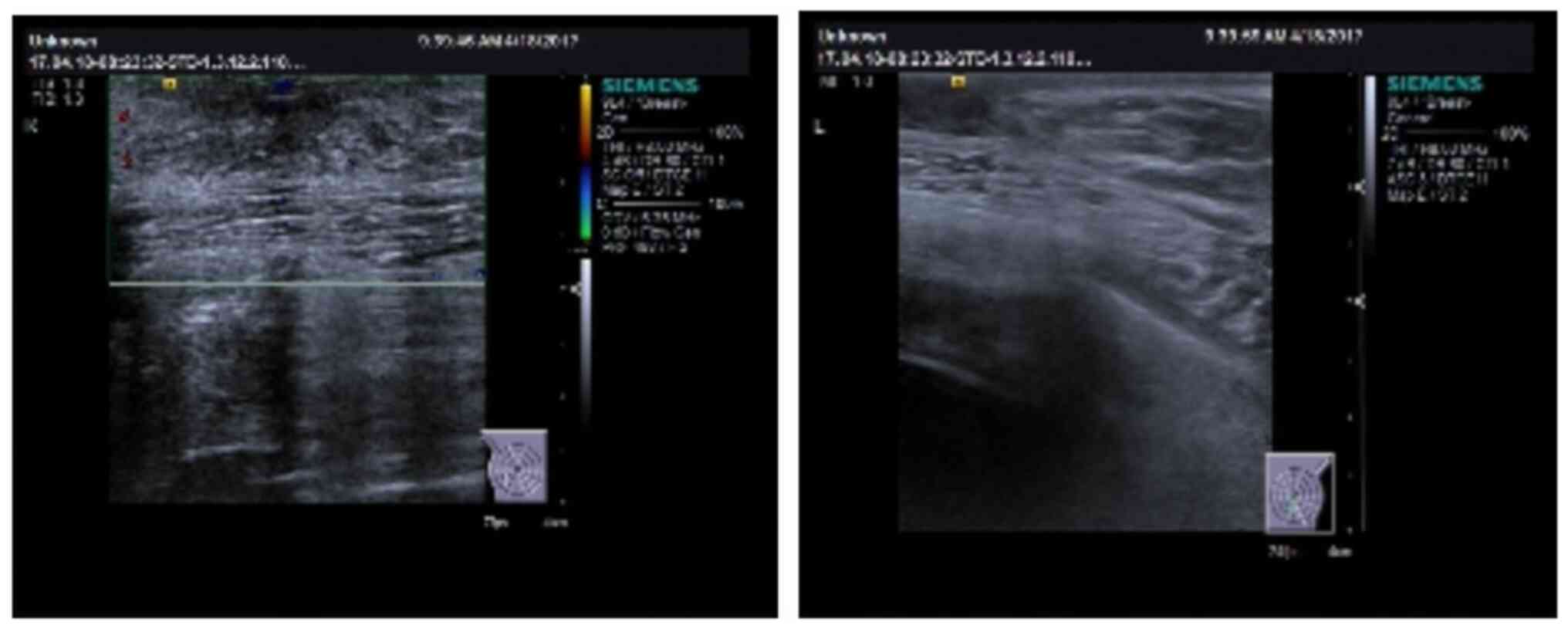Imatinib‑induced gynecomastia: A case report
- Authors:
- Published online on: September 11, 2024 https://doi.org/10.3892/etm.2024.12714
- Article Number: 425
-
Copyright: © Li et al. This is an open access article distributed under the terms of Creative Commons Attribution License.
Abstract
Introduction
Chronic myeloid leukemia (CML) is a type of malignant tumor formed by the clonal proliferation of bone marrow hematopoietic stem cells (1). A majority of patients with CML exhibit slow disease progression and remain asymptomatic in the early stages of disease (2). The pathogenesis of CML is attributed to ectopic rearrangement of chromosomes 9 and 22, which produce an abnormal BCR activator of RhoGEF and GTPase-ABL proto-oncogene (BCR-ABL) fusion gene (3). This fusion gene can produce an abnormal protein with tyrosine kinase activity, which prompts increased cell proliferation and may lead to CML pathogenesis (4). Therefore, tyrosine kinase inhibitors (TKIs) targeting BCR-ABL have exhibited high efficacy in CML treatment. Imatinib (IM) is the first-line treatment for CML (4,5). The use of IM and second-generation TKIs, such as nilotinib and dasatinib, has considerably prolonged disease-free survival in patients with CML (4,5). However, despite its excellent safety profile, IM can cause certain adverse reactions, including edema, nausea, vomiting, joint and muscle pain, rash, fatigue, abdominal distension, diarrhea, muscle spasms, liver and kidney dysfunction, bleeding, ascites and exfoliative dermatitis (6). Rare, but potentially adverse reactions with a risk of morbidity, have also been reported. These rare adverse effects include splenic rupture, severe rash, hair repigmentation, bone marrow necrosis, acute fulminant hepatitis, breast carcinoma and male gynecomastia (7-9). The present study reports a case of IM-induced gynecomastia and aims to discuss the therapeutic considerations in this unique population.
Case report
A 48-year-old male patient was admitted to the Department of Gastroenterology of The First Affiliated Hospital of Jishou University (Jishou, China) in March 2016 with a complaint of abdominal distension persisting for over 2 months. Physical examinations showed splenomegaly with three transverse fingers under the splenic ribs. Routine blood tests showed a white blood cell count of 342.48x109/l (normal range, ~4.00-10.00x109/l), a hemoglobin count of 82 g/l (normal range, 110-150 g/l), a platelet count of 242x109/l (normal range, ~100-400x109/l) and a mean corpuscular volume size of 104.90 fl (normal range, 80.00-100.00 fl). Abdominal color ultrasound results demonstrated an enlarged spleen measuring ~164 mm in length and ~52 mm in thickness (Fig. 1). The patient was advised to undergo treatment at the Department of Hematology of The First Affiliated Hospital of Jishou University.
The patient had a history of hepatitis B and hepatitis E infection, and took entecavir capsule to control the proliferation of HBV, but their liver function (Hitachi 7060 automatic biochemical analyzer; Shanghai Kehua Bio-Engineering Co., Ltd.) and liver color ultrasound were normal, and the nucleic results of hepatitis B virus were <2.00 IU/ml (normal range, <2.00 IU/ml). The patient had no history of alcohol consumption. Bone marrow testing (10) was performed after admission to hospital. Hyperactive bone marrow proliferation was shown, with the proliferation of various stages of the neutral myelocytes (5% acidophils and 3% alkalophils; 200 cells were manually counted under a microscope, and the specific values are the ratio of acidophils and alkalophils in 200 cells multiplied by 100%) (Fig. 2). These findings were consistent with the symptoms of CML. The results of a bone marrow biopsy (fixed with Bouin fluid; thickness, 3 µm; lined separately for hepatocyte growth factor, H&E and Gomori staining) (11-13) demonstrated active bone marrow hyperplasia with an increased granulocyte/erythrocyte ratio and granular hyperplasia, containing mature cells and acidophilic granulocytes (Fig. 3). The bone marrow chromosome test results (GTG banding; ISCN 2009) (14,15) demonstrated the presence of the Philadelphia chromosome (Fig. 4). The results of bone marrow fluorescence in situ hybridization experiment to detect BCR/ABL fusion were positive (Fig. 5). Quantification of the BCR/ABL fusion gene P210 was performed using a two-color dual-fusion DNA probe (Beijing Jinpujia Medical Technology Co., Ltd.) and imaged using an OLYMPUS-BX51 fluorescence microscope (Olympus Corporation) (16). The quantification of the BCR/ABL fusion gene (BCR-ABL copy number/ABL copy number x100%) was demonstrated to be 251.9126% (17). Considering the patient's symptoms and the results of blood and bone marrow-related tests, a diagnosis of CML-chronic phase with a Sokal score of 1.2(18) was suggested. After admission, the patient was treated with hydroxyurea (1.0 g orally three times a day) for 2 weeks in March 2016 and then with 400 mg of IM/day since the CML diagnosis in March 2016 (400 mg/day from March 2016; 300 mg/day from April 2017; 400 mg/day from January 2018). Routine treatment with 400 mg of IM/day was continued after hospital discharge. In July 2016, October 2016, January 2017 and April 2017, the peripheral blood BCR/ABL fusion gene P210 quantification was 3.20, 0.16, 0.05 and 0.125%.
In January 2017, the patient visited the breast and thyroid clinic at the aforementioned hospital with a complaint of double breast pain. Color ultrasound of breast tissues demonstrated that the size of the left breast was ~14x13x6 mm and the size of the right breast was ~27x29x8 mm. Right breast enlargement was observed (Fig. 6). The patient was then advised to undergo breast surgery, but refused. A color ultrasound performed in April 2017 to determine whether the mammary gland exhibited an enlargement trend showed that the right breast gland had a size of 34x27x11 mm (Fig. 7). A sex hormone test of a peripheral blood sample demonstrated a marginal increase in progesterone levels (Table I). After follow-up, the potential adverse effects caused by IM were considered. As the androgen level was not decreased, testosterone undecanaic acid was not administered. A reduction of the IM dose to 300 mg/day was recommended to the patient to reduce the adverse side effects. After this change in the treatment plan, the severity of the patient's symptoms and the size of both breasts decreased, and the patient reported no breast pain. Quantification of peripheral BCR/ABL fusion gene expression was reported to be 0.067, 0.122 and 0.454% in July 2017, December 2017 and January 2018, respectively. Subsequently, the IM dose was increased to 400 mg/day. Owing to the side effects of IM and poor treatment efficacy, the patient underwent dasatinib (orally; 100 mg/day) treatment since March 2018. A subsequent BCR/ABL quantification test showed negative results and the patient reported no abnormal breast development. Whilst undergoing dasatinib treatment, a color ultrasound showed normal liver, gallbladder and splenic function (Fig. 8). Peripheral blood liver and renal function and HBV-DNA results were normal (Table II). In May 2024, the patient underwent follow-up in the outpatient clinic. No specific symptoms were observed during the last follow-up appointment. The patients will be followed up in the outpatient clinic every 1-2 months.
Discussion
Gynecomastia is highly prevalent in the elderly and may affect up to 24-65% of men among those aged 50-80 years (19). Unlike in children and young adults, gynecomastia in older adults is more likely to be associated with certain pathological factors. Pathological gynecomastia is associated with several factors, including liver cirrhosis, drug therapy, hypogonadism, malnutrition, hyperthyroidism, testicular tumors and chronic kidney disease (20). IM is an antitumor-targeted chemotherapeutic agent that inhibits tyrosine kinase receptors, including c-Kit, BCR-ABL and platelet-derived growth factor receptors (PDGFRs). These receptors regulate a number of cellular processes, including cell proliferation, differentiation and survival (21). Despite its excellent safety profile, IM can cause distinct side effects, such as edema, nausea, vomiting, fatigue, splenic rupture, severe rash, breast cancer and gynecomastia (8,22). The present study reported a rare case of IM-induced gynecomastia in a patient with CML.
A limited number of studies have reported findings on gynecomastia occurring in response to IM treatment (9,23-29). The patient in the present study developed gynecomastia ~10 months after starting treatment with IM. During IM administration, the patient took the ‘entecavir capsule’ to control HBV replication and without any solid tumors. Therefore, it was hypothesized that gynecomastia was an adverse reaction caused by IM. However, owing to the small number of cases currently published, the relationship between IM and gynecomastia remains unclear. Therefore, the relevant literature was reviewed using PubMed (https://pubmed.ncbi.nlm.nih.gov/?term=imatinib+and+gynecomastia&size=50; key words, imatinib and gynecomastia) and discussed.
The literature suggested that free testosterone levels decrease and estrogen levels increase in response to IM administration, thus indicating that an imbalance in sex hormone levels may lead to gynecomastia (26-29). IM, as a TKI, can selectively block the c-Kit receptor and PDGFR via the same mechanism (30), both of which are expressed in both male and female gonads. By binding with its ligands, IM can promote the proliferation and development of primordial germ cells, thus maintaining their normal physiological function and survival. In addition, IM also promotes the secretion of testosterone by testicular stromal cells and ovarian endometrial cells (31,32). A number of clinical trials conducted on animals and patients have reported that the serum levels of testosterone, follicular hormone and luteinizing hormone increase significantly in response to IM use (33). Hormone tests conducted on patients treated with IM in China showed that the triiodothyronine levels of some patients decreased and their thyroid-stimulating hormone levels increased, whilst the testosterone levels of some male patients decreased (34). These changes in hormone levels were related to a number of corresponding clinical symptoms, such as body temperature drop, cold hands and feet, loss of appetite, fatigue, dizziness, memory loss, and edema for low triiodothyronine levels, fear, myxoedema, weight gain and increased heart rate for high thyroid-stimulating hormone levels, and decreased sexual desire, lack of energy, mood abnormalities and osteoporosis for low testosterone levels. These effects were also related to the duration of drug administration; testosterone decreased with administration time and was negatively associated with administration time (34). Among second-generation TKIs, dasatinib and nilotinib are also multitarget inhibitors of target receptors such as c-Kit, tyrosine kinases and PDGFR (35). Caocci et al (36) reported a case of gynecomastia in a patient with CML receiving dasatinib. Therefore, the aforementioned studies indicated that IM may affect the function of certain receptors, such as c-Kit and PDGFR, which causes an imbalance in physiological sex hormone levels and can lead to the abnormal development of breasts in male patients.
It has also been reported that gynecomastia caused by IM may be dose-dependent. Gambacorti-Passerini et al (27) reported a significant association between the therapeutic dose of IM and gynecomastia, with IM doses of 600-800 mg/day reducing testosterone levels more than 400 mg/day IM. Zhao et al (29) achieved satisfactory treatment efficacy by subsequently reducing the IM dose from 400 to 300 mg in patients with CML. In the present case, the IM dose was reduced from 400 to 300 mg/day, which improved the symptoms reported by the patient. Subsequently, the patient was recommended an alternative treatment, dasatinib, owing to the poor efficacy and side effects of IM. Upon dasatinib treatment, the patient did not show further signs of gynecomastia. This suggested that gynecomastia in the patient in the present report was likely a side effect of IM treatment.
Gynecomastia can be treated using radiotherapy, surgery and medication. Drugs such as androgens, antiestrogens, aromatase inhibitors, tamoxifen and danazol are reported to be effective for the treatment gynecomastia (25,32,37,38).
With the continuous use of new and increasingly effective TKIs, published reports on IM-induced male breast development have decreased. However, clinicians should be aware of such adverse reactions. Based on the results of the present case report, it could be recommended that clinicians assess the hormonal status of each patient before and during treatment and take timely measures to compensate for the adverse consequences of sex hormone imbalance.
Acknowledgements
Not applicable.
Funding
Funding: The present study was supported by the Innovation Platform and talent program of Hunan Province (grant no. 2021SK4050) and the Natural Science Foundation of Hunan Province (grant nos. 2023JJ30608 and 2023JJ30609).
Availability of data and materials
The data generated in the present study may be requested from the corresponding author.
Authors' contributions
XLL, ML and ZWS were responsible for collecting clinical, imaging and pathological data of the patient and drafting the manuscript. HJF, SKT and LZW analyzed the data. KS designed the study. JT participated in making the pathological diagnosis and was involved in data collection and analysis. XLL and KS confirm the authenticity of all the raw data. All authors read and approved the final version of the manuscript.
Ethics approval and consent to participate
Not applicable.
Patient consent for publication
Written consent for publication of the case report and any accompanying images, without any potentially identifying information, was provided by the patient.
Competing interests
The authors declare that they have no competing interests.
References
|
Sun J, Hu R, Han M, Tan Y, Xie M, Gao S and Hu JF: Mechanisms underlying therapeutic resistance of tyrosine kinase inhibitors in chronic myeloid leukemia. Int J Biol Sci. 20:175–181. 2024.PubMed/NCBI View Article : Google Scholar | |
|
Arzoun H, Srinivasan M, Thangaraj SR, Thomas SS and Mohammed L: The progression of chronic myeloid leukemia to myeloid sarcoma: A systematic review. Cureus. 14(e21077)2022.PubMed/NCBI View Article : Google Scholar | |
|
Zhou T, Medeiros LJ and Hu S: Chronic myeloid leukemia: Beyond BCR-ABL1. Curr Hematol Malig Rep. 13:435–445. 2018.PubMed/NCBI View Article : Google Scholar | |
|
Jabbour E and Kantarjian H: Chronic myeloid leukemia: 2016 Update on diagnosis, therapy, and monitoring. Am J Hematol. 91:252–265. 2016.PubMed/NCBI View Article : Google Scholar | |
|
Stagno F, Stella S, Spitaleri A, Pennisi MS, Di Raimondo F and Vigneri P: Imatinib mesylate in chronic myeloid leukemia: Frontline treatment and long-term outcomes. Expert Rev Anticancer Ther. 16:273–278. 2016.PubMed/NCBI View Article : Google Scholar | |
|
Kantarjian H, Sawyers C, Hochhaus A, Guilhot F, Schiffer C, Gambacorti-Passerini C, Niederwieser D, Resta D, Capdeville R, Zoellner U, et al: Hematologic and cytogenetic responses to imatinib mesylate in chronic myelogenous leukemia. N Engl J Med. 346:645–652. 2002.PubMed/NCBI View Article : Google Scholar | |
|
Kaygusuz-Atagunduz I, Toptas T, Yumuk F, Firatli-Tuglular T and Bayik M: Newly diagnosed breast cancer in a patient receiving imatinib mesylate. J Cancer Res Ther. 10:1107–1108. 2014.PubMed/NCBI View Article : Google Scholar | |
|
Pan L, Duan J, Qiao W, Bi L, Wu D, Fan Z and Yang M: Secondary breast carcinoma after completely remitted chronic myeloid leukemia following targeted tyrosine kinase inhibitor therapy. Breast Cancer. 24:790–793. 2017.PubMed/NCBI View Article : Google Scholar | |
|
Tanriverdi O, Unubol M, Taskin F, Meydan N, Sargin G, Guney E and Barutca S: Imatinib-associated bilateral gynecomastia and unilateral testicular hydrocele in male patient with metastatic gastrointestinal stromal tumor: A literature review. J Oncol Pharm Pract. 18:303–310. 2012.PubMed/NCBI View Article : Google Scholar | |
|
Li N, Zhao L, Li J, Ding Y, Shen Y, Huang X, Wang X and Wang J: Turner syndrome caused by rare complex structural abnormalities involving chromosome X. Exp Ther Med. 14:2265–2270. 2017.PubMed/NCBI View Article : Google Scholar | |
|
Gala JL, Chenut F, Hong KB, Rodhain J, Camby P, Philippe M and Scheiff JM: A panel of antibodies for the immunostaining of Bouin's fixed bone marrow trephine biopsies. J Clin Pathol. 50:521–524. 1997.PubMed/NCBI View Article : Google Scholar | |
|
Narang NC, Rusia U, Sikka M and Kotru M: Morphological changes in bone marrow post imatinib therapy in chronic phase CML: A follow up study on sequential bone marrow aspirates and Biopsies. J Clin Diagn Res. 11:EC25–EC29. 2017.PubMed/NCBI View Article : Google Scholar | |
|
Xu YW and Duan MH: A unique bone marrow lymphoma patient presenting with an isolated mass: A case report. Oncol Lett. 15:2529–2533. 2018.PubMed/NCBI View Article : Google Scholar | |
|
Al-Achkar W, Wafa A and Nweder MS: A complex translocation t(5;9;22) in philadelphia cells involving the short arm of chromosome 5 in a case of chronic myelogenous leukemia. J Exp Clin Cancer Res. 26:411–415. 2007.PubMed/NCBI | |
|
Shaffer LG, Slovak ML and Campbell LJ (eds): ISCN 2009: An international system for human cytogenetic nomenclature. S. Karger, Basel, 2009. | |
|
Ewers E, Yoda K, Hamid AB, Weise A, Manvelyan M and Liehr T: Centromere activity in dicentric small supernumerary marker chromosomes. Chromosome Res. 18:555–562. 2010.PubMed/NCBI View Article : Google Scholar | |
|
Shen X, Zhang M, Shen Y, Shi W, Liu W and Wei WU: Nilotinib rapidly reverses breakpoint cluster region-Abelson oncogene fusion gene and M244V mutations in a patient with chronic myelogenous leukemia: A case report. Exp Ther Med. 10:1479–1482. 2015.PubMed/NCBI View Article : Google Scholar | |
|
Syed NN, Usman M, Khaliq G, Adil SN and Khurshid M: Clinico-pathologic features of chronic myeloid leukemia and risk stratification according to Sokal score. J Coll Physicians Surg Pak. 16:336–339. 2006.PubMed/NCBI | |
|
Leung AKC and Leung AAC: Gynecomastia in infants, children, and adolescents. Recent Pat Endocr Metab Immune Drug Discov. 10:127–137. 2017.PubMed/NCBI View Article : Google Scholar | |
|
Karamchandani MM, De La Cruz Ku G, Sokol BL, Chatterjee A and Homsy C: Management of gynecomastia and male benign diseases. Surg Clin North Am. 102:989–1005. 2022.PubMed/NCBI View Article : Google Scholar | |
|
Kadivar A, Ibrahim Noordin M, Aditya A, Kamalidehghan B, Davoudi ET, Sedghi R and Akbari Javar H: Antiproliferative effects of imatinib mesylate on ZR-75-1 and MDA-MB-231 cell lines via PDGFR-β, PDGF-BB, c-Kit and SCF expression. Int J Mol Med. 42:414–424. 2018.PubMed/NCBI View Article : Google Scholar | |
|
Ma Z, Zhao J, Li S, Gao F, Zhang C, Wu L and Lin Y: Imatinib-induced ulcerative colitis. J Oncol Pharm Pract: 10781552241255290, 2024 (Epub ahead of print). | |
|
Gupta P, Cherian KE, Kapoor N, Fouzia NA and Paul TV: IM-induced gynecomastia. Indian J Endocrinol Metab. 23(648)2019.PubMed/NCBI View Article : Google Scholar | |
|
Kim H, Chang HM, Ryu MH, Kim TW, Sohn HJ, Kim SE, Kang HJ, Park S, Lee JS and Kang YK: Concurrent male gynecomastia and testicular hydrocele after imatinib mesylate treatment of a gastrointestinal stromal tumor. J Korean Med Sci. 20:512–515. 2005.PubMed/NCBI View Article : Google Scholar | |
|
Liu H, Liao G and Yan Z: Gynecomastia during imatinib mesylate treatment for gastrointestinal stromal tumor: A rare adverse event. BMC Gastroenterol. 11(116)2011.PubMed/NCBI View Article : Google Scholar | |
|
Jain A, Varma S, Garg R and Malhotra P: Unilateral gynaecomastia in a young man with chronic myeloid leukemia. Indian J Hematol Blood Transfus. 33:448–450. 2017.PubMed/NCBI View Article : Google Scholar | |
|
Gambacorti-Passerini C, Tornaghi L, Cavagnini F, Rossi P, Pecori-Giraldi F, Mariani L, Cambiaghi N, Pogliani E, Corneo G and Gnessi L: Gynaecomastia in men with chronic myeloid leukaemia after imatinib. Lancet. 361:1954–1956. 2003.PubMed/NCBI View Article : Google Scholar | |
|
Tavil B, Kınık S, Gözen A and Olcay L: Gynecomastia in a boy with chronic myeloid leukemia during imatinib therapy. Turk J Haematol. 30:336–337. 2013.PubMed/NCBI View Article : Google Scholar | |
|
Zhao D, Wang G, Li C and Meng L: Bilateral masculine mastoplasia associated with imatinib mesylate: A case report and literature review. J Huazhong Univ Sci Technolog Med Sci. 31:145–146. 2011.PubMed/NCBI View Article : Google Scholar | |
|
Griffin J: The biology of signal transduction inhibition: Basic science to novel therapies. Semin Oncol. 28 (5 Suppl 17):S3–S8. 2001.PubMed/NCBI | |
|
Sette C, Dolci S, Geremia R and Rossi P: The role of stem cell factor and of alternative c-kit gene products in the establishment, maintenance and function of germ cells. Int J Dev Biol. 44:599–608. 2000.PubMed/NCBI | |
|
Basciani S, Brama M, Mariani S, De Luca G, Arizzi M, Vesci L, Pisano C, Dolci S, Spera G and Gnessi L: Imatinib mesylate inhibits Leydig cell tumor growth: Evidence for in vitro and in vivo activity. Cancer Res. 65:1897–1903. 2005.PubMed/NCBI View Article : Google Scholar | |
|
Ghalaut VS, Prakash G, Bansal P, Dahiya K, Dokwal S, Ghalaut PS, Bala M and Dhankhar R: Effect of imatinib on male reproductive hormones in BCR-ABL positive CML patients: A preliminary report. J Oncol Pharm Pract. 20:243–248. 2014.PubMed/NCBI View Article : Google Scholar | |
|
Hou Z, Zhu HL and Liu T: Effects of imatinib mesylate on the levels of endocrine hormones. Zhonghua Xue Ye Xue Za Zhi. 34:762–766. 2013.PubMed/NCBI View Article : Google Scholar : (In Chinese). | |
|
Lindauer M and Hochhaus A: Dasatinib. Recent Results Cancer Res. 212:29–68. 2018.PubMed/NCBI View Article : Google Scholar | |
|
Caocci G, Atzeni S, Orrù N, Azzena L, Martorana L, Littera R, Ledda A and La Nasa G: Gynecomastia in a male after dasatinib treatment for chronic myeloid leukemia. Leukemia. 22:2127–2128. 2008.PubMed/NCBI View Article : Google Scholar | |
|
Prasetyono TOH, Andromeda I and Budhipramono AG: Approach to gynecomastia and pseudogynecomastia surgical techniques and its outcome: A systematic review. J Plast Reconstr Aesthet Surg. 75:1704–1728. 2022.PubMed/NCBI View Article : Google Scholar | |
|
McLeod DG and Iversen P: Gynecomastia in patients with prostate cancer: A review of treatment options. Urology. 56:713–720. 2000.PubMed/NCBI View Article : Google Scholar |



